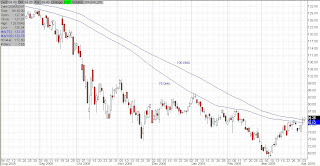
Click chart to enlarge
We bought some SSO when the market broke through the top of its downtrending moving average where indicated by the first purple arrow on the chart above. Somewhere there is a post or comment made at the time about this trade. We sold some DDM when the market broke the uptrending channel at the second purple arrow. There is a post or comment that mentions that, too. These were our only trades for the time period shown on the chart above.
The reason we mention this is because it seems there is some confusion on this blog about the purpose of the channels/averages and TA in general. We tried to sum it up on the previous thread in a comment to Anon, then realized that a picture is worth a thousand words, hence this new post. The bottom line is that since the market broke the channel and moving average, we're in no man's land right now. You must be cautious because the market does not have a clear direction as it did when it was in its downtrending channel or when it was in its uptrending channel. Until a new channel forms, the market is in limbo (stage 3).
Here is our comment to Anon on the previous thread...
Anon, there are four stages...
Stage 1- sideways after a downtrend - choppy, breaks the moving average many times in both directions
Stage 2- uptrend (price is above uptrending moving average)
Stage 3- sideways after an uptrend - choppy, breaks the moving average many times in both directions
Stage 4- downtrend (price is below a downtrending moving average)
These stages typically take months or years to play out, using the 200dma as the average. We've applied the concept to the current short term rally just to get a better idea of how to time it for ourselves. Right now, the market as a whole is no doubt in a Stage 4 downtrend. There's no disputing that. It is trending lower below a downtrending 200dma. If you zero in on just this little multi-week rally that we're having, then the market is in a little Stage 3. It is no longer in a Stage 2 uptrend. Nor is it in a Stage 4 downtrend... yet. Once it enters Stage 4, if it does, then you have to assume it's going to zero until it stops falling. It may just be resting right now, consolidating the recent huge advance of the past several weeks. We may start a new Stage 2 uptrend after this consolidation is over, or we may fall into a Stage 4 downtrend. Nobody knows. We sold some DDM when the channel broke because we had left the Stage 2 uptrend, making the market riskier going ahead. It isn't that we thought it would tank, it's just that once the channel was broken, the odds of it rallying further were much less than they were when the channel was intact.TA is not meant to give you foolproof buy and sell signals, although sometimes it does. What it really does is helps you put the odds in your favor over time.Right now, the market is less decisive than it was when it was in the channel. It could go either way. We buy the dips when the market is in the channel. Right now, we would not buy the dips because if one of these dips makes a new low, we may be starting a Stage 4. You see, the stages help you decide what mood to be in... bullish, cautious, bearish, etc.Right now, we're in a short term Stage 3, so our mood is neither bullish nor bearish, it's cautious.




